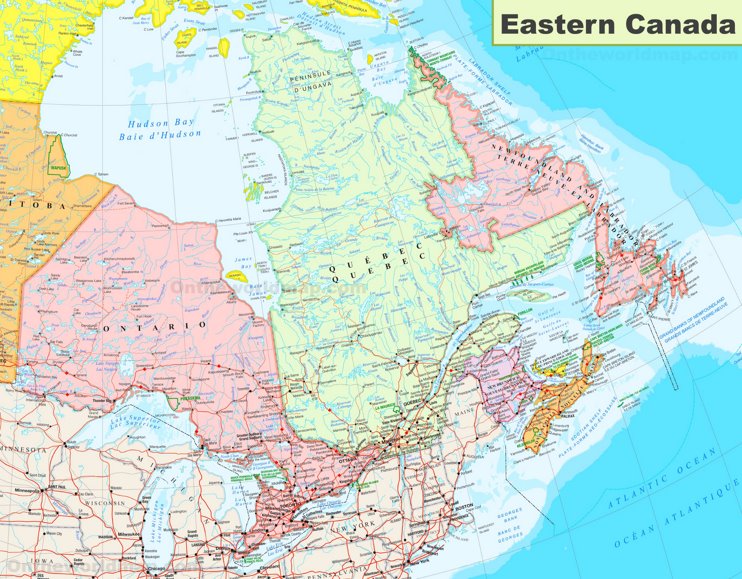Map of Eastern Canada
Description:
This map shows provinces, cities, towns, highways, roads, railways, ferry routes, and national parks in Eastern Canada.
You may download, print or use the above map for educational, personal and non-commercial purposes. Attribution is required. For any website, blog, scientific research or e-book, you must place a hyperlink (to this page) with an attribution next to the image used.
About Eastern Canada
Eastern Canada, also referred to as Central Canada or Eastern provinces, is a region of Canada that typically includes the provinces of Ontario and Quebec, and sometimes extends to include the four Atlantic provinces: New Brunswick, Nova Scotia, Prince Edward Island, and Newfoundland and Labrador. Ontario and Quebec, often designated as Central Canada, form the country's most populous and economically significant region. According to the 2021 census, Ontario had a population of 14,223,942, representing approximately 38.5% of Canada's total population, while Quebec had 8,501,833 residents, accounting for about 24%. Combined, these two provinces contain over 62% of the Canadian population.
Toronto, the capital of Ontario and Canada's largest city, serves as the nation's financial and commercial center. Montreal in Quebec is the country's second-largest city and a major cultural hub. Ottawa, located in Ontario on the border with Quebec, functions as Canada's national capital.
Quebec is unique as the only Canadian province where French is the sole official language at the provincial level, with approximately 81% of its population being francophone. The province's name derives from an Algonquian word meaning "narrow passage" or "strait." Ontario's name is thought to originate from Indigenous languages, possibly from the Huron word meaning "great lake." Ontario is Canada's leading manufacturing province and contains the Canadian Shield, which covers over half of its land area. The province's economy is highly diversified, with strong sectors in manufacturing, services, finance, and technology.
The Atlantic provinces of Eastern Canada include New Brunswick, the only officially bilingual province in Canada where both English and French have equal status. New Brunswick is home to the Bay of Fundy, which experiences the world's highest tides, reaching up to 16 meters. Nova Scotia, whose name means "New Scotland" in Latin, has the most lighthouses of any Canadian province and a coastline exceeding 8,000 miles. The region's economy historically relied on fishing, forestry, and mining, though service industries have become increasingly important. The Atlantic provinces joined Canadian Confederation in 1867, alongside Ontario and Quebec, forming the original four provinces of modern Canada.
Maps of Canada
Provinces and Territories
Cities of Canada
Cities of Canada

